Macadamia Market Research, 2031
The global macadamia market size was valued at $1.1 billion in 2021, and is projected to reach $2.9 billion by 2031, growing at a CAGR of 10.3% from 2022 to 2031.
Macadamia is nut obtained from macadamia trees and is highly cultivated in Australia, the U.S., China, and different parts of Africa. Macadamia consumption is extensively high in high-income countries such as the U.S., China, Canada, Japan, Australia, and France. According to the International Nut & Dried Fruit Council, the production volumes of macadamia (kernel basis) is continuously rising over the past 10 years, reaching at 62,800 metric tons in 2020, up 4% from 2019 production figures. The rising application of macadamia in various industries such as pharmaceuticals, personal care and cosmetics, and the food and beverages industry is expected to boost the growth of the global macadamia industry in the near future.

Market Dynamics
The global macadamia market is expected to witness significant growth owing to a rise in the demand for plant-based snacks. The easy availability of various macadamia-based snacks in a variety of flavors has attracted health-conscious consumers and contributed to the market growth in the past few years. There is a huge rise in the demand for plant-based proteins. As per the report of the government of Canada, “While the total protein demand will double to 943.5 million metric tons in 2054, the market for alternative proteins, including plant-based proteins, is expected to grow at 14% annually by 2024 — up to a third of the protein market.” The booming plant-protein industry is now developing novel functional foods and value-added products that replace animal proteins. Owing to a such rise in the demand for plant-based proteins there will be a rise in the macadamia market demand since the greatest way to fulfill one's daily protein and fat needs without ingesting any animal protein is to eat macadamia nuts. As a result, customers can maintain their vegan diets without developing lactose intolerance.
A significant factor in the industry's expansion has been the public's growing understanding of the advantages of nuts for health. Additionally, macadamia nuts are used to create macadamia oil, which is becoming well-liked by both customers and enterprises. According to the International Nut & Dried Fruit Organization Over the last decade, global tree nut production has steadily increased, reaching over 5.3 million metric tons in season 2020/2021, up 15% from 2019/20 and 65% higher than a decade earlier. Macadamia nuts have various benefits like they are rich in nutrients, may boost heart health, it is loaded with antioxidants, and others. Owing to these benefits of macadamia nuts its demand is significantly increasing which will drive the macadamia market growth.
The oil made up of edible macadamia nuts is called macadamia ternifolia seed oil or macadamia integrifolia seed oil. The oil works as a skin conditioning agent. According to the National Library of Medicine U.S. macadamia oil also contains a lot of oleic acids, which is great for softening the skin, regenerating skin cells, moisturizing the skin, and is a natural anti-inflammatory. Linoleic acid content helps restore skin barrier function and reduces transepidermal water loss (TEWL). According to the Australian Macadamias Organization boasting a smooth buttery flavor, macadamia oil is great for roasting, baking, and deep-frying, and can also be used as a base for salad dressings and even a substitute for butter when baking. Due to these uses in cosmetics and cooking of macadamia oil the market will have an opportunity for growth.
Segmental Overview
According to the macadamia market analysis, the market is segregated based on form, end use, nature, distribution channel, and region. Based on the form, the market is divided into processed, raw, and oil. Further, on the basis of end use, the market is segmented into food and beverage, personal care and cosmetic, residential, and pharmaceuticals. The food and beverage segment is further bifurcated into snacks, bakery and confectionery, beverages, desserts, and others. Based on the nature, the market is segregated into organic and conventional. Depending on the distribution channel, it is divided into B2B and B2C. Region-wise, the market is analyzed across North America, Europe, Asia-Pacific, and LAMEA.
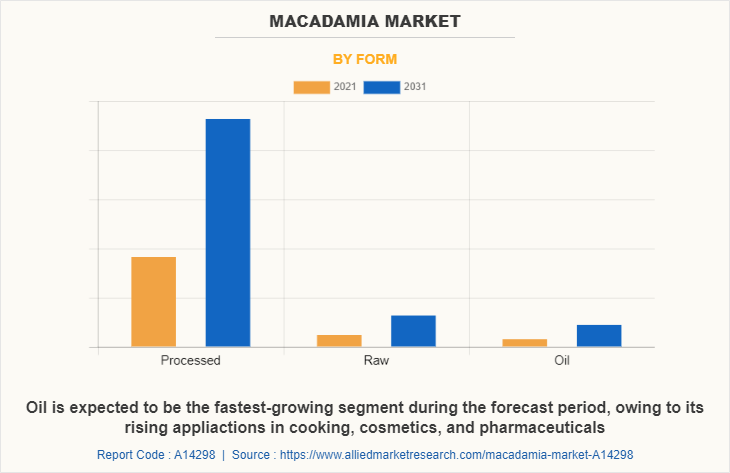
By Form
As per the macadamia market forecast, based on the form, the processed segment dominated the market accounting for around 82.5% of the macadamia market share in 2021. The rise in applications of macadamia nuts for producing various products such as edible oil, snacks, confectioneries, desserts, cosmetics, and bakeries has significantly fostered the demand for processed macadamia across the globe. The significantly rising demand for healthy snacking among the global population coupled with the rising awareness regarding the health benefits of macadamia nuts and its by-products is expected to boost the demand for processed macadamia in the residential and commercial sectors.
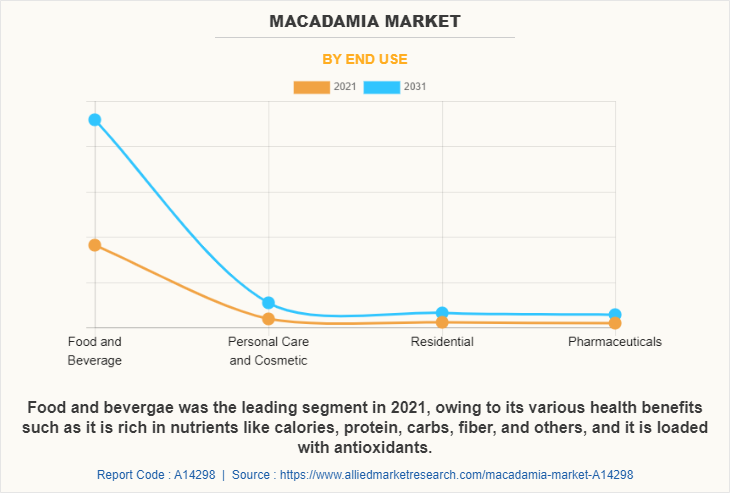
By End Use
As per the macadamia market share, depending on the end use, the food and beverage segment dominated the market in 2021. This dominance is attributed to the huge applications of macadamia in the global food and beverage industry. Macadamia and macadamia-based ingredients have huge adoption among the manufacturers of snacks, confectioneries, bakeries, desserts, and beverages. The natural presence of essential nutrients and monosaturated fats in macadamia makes it a healthy and desirable ingredient in a variety of food and beverage products. Moreover, the rising penetration of packaged food and food processing companies in developed and developing nations are expected to boost the growth of this segment during the forecast period.
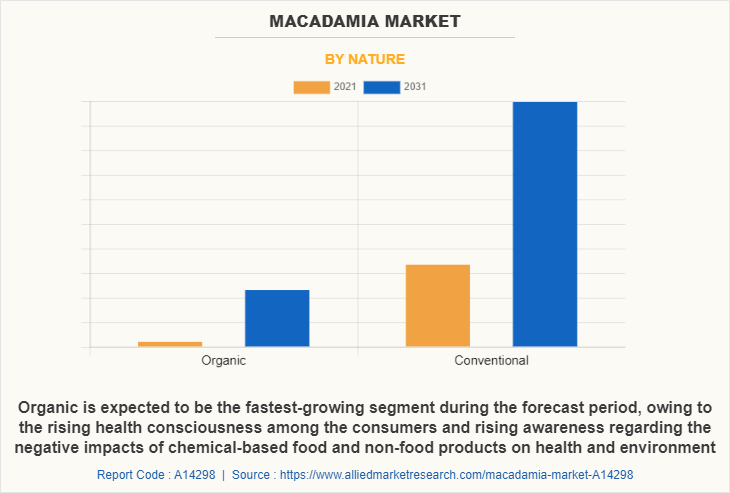
By Nature
Based on nature, organic is estimated to be the fastest-growing segment, witnessing a CAGR of 11.1% during the forecast period. Organic macadamia is made from organically farmed macadamia nuts that are processed to prepare various food, beverages, and cosmetic products. Organic macadamia is gaining rapid momentum among consumers. The growing demand for organic and natural products, as well as the health benefits of organic food products, are the two main factors driving the growth of the organic macadamia market. According to Organic Trade Association (OTA), in the year 2020-21, organic sales exceeded $63 billion, with total annual growth of $1.4 billion. Food sales, which accounted for more than 90% of organic sales, reached $57.5 billion (approximately 2% growth) and non-food sales reached $6.0 billion (7% growth) in U.S. Additionally, the increasing popularity of home-cooked food and the growing number of cooking shows and blogs are also helping to drive the market growth.
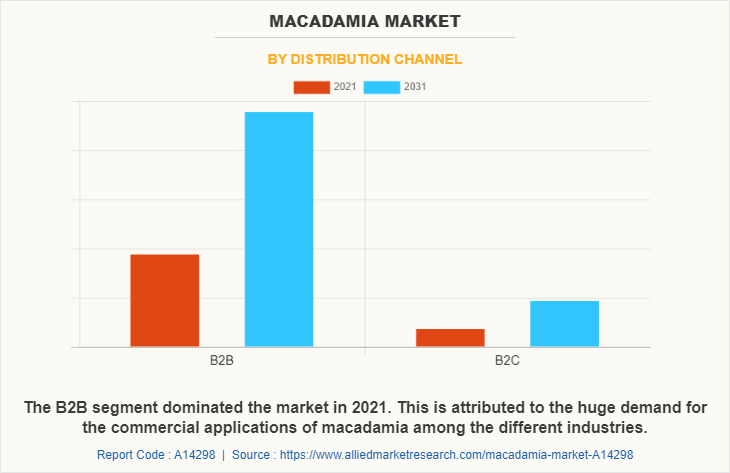
By Distribution Channel
Depending on the distribution channel, B2B segment dominated the global market, accounting for a market share of 84.4% in 2021. The rising adoption of macadamia oil and raw nuts in household kitchens to make different dishes is fueling the growth of the B2C segment and is expected to be the fastest-growing segment during the forecast period. The presence of a huge number of macadamia producers and the surging demand for it in the food and beverages and cosmetics industry has led to the significant growth of the B2B segment in the market. Moreover, the rising popularity of online B2B marketplaces such as India Mart, Alibaba, eWorld Trade, Global Sources, Amazon Business, and Just Dial is expected to have a significant positive impact on the growth of the macadamia market in the upcoming future. The availability of macadamia in huge volumes and at reasonable prices has led to the rapid growth of the B2B segment in the global market.
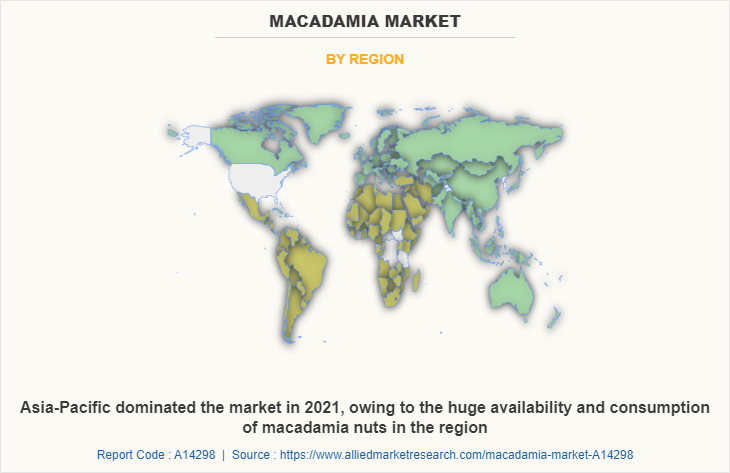
By Region
Region-wise, the macadamia market growth is analyzed across North America, Europe, Asia-Pacific, and LAMEA. Asia-Pacific dominated the global market garnering a revenue share of 42.8% in 2021, followed by North America with 37.8%. The huge demand, high consumption, and availability of macadamia in high volumes have led to the dominance of the Asia-Pacific in the global market.
Asia-Pacific macadamia market is analyzed across China, Japan, India, Malaysia, South Korea, Australia, and the rest of Asia-Pacific. China dominated the market with a revenue share of 55.5% in Asia-Pacific in 2021, followed by Australia with 15.6% and Japan with 14.1%. Asia-Pacific is among the top producers of macadamia in the globe. In 2020, Australia accounted for 25% of the global macadamia production (kernel basis), and China and Vietnam with 14% and 3%, respectively. The macadamia market is expected to grow owing to the increasing usage of macadamia in the food & beverage, pharmaceutical, and cosmetic industries. Along with these factors, the use of macadamia nuts as a gift in China during the Chinese New Year will also help the market is growing at a significant rate. China is the second and Australia is the third largest consumer of macadamia with a consumption of 11,033 and 3,448 metric tons as per the International Nut & Dried Fruit Council. Along with these factors, rapid urbanization and the huge population will also drive the market for the region.
LAMEA is anticipated to be the fastest-growing market during the forecast period. LAMEA is the abbreviation for Latin America, the Middle East, and Africa. The major markets analyzed in the LAMEA region are Brazil, Colombia, Saudi Arabia, UAE, Israel, and the rest of LAMEA. Brazil was the leading macadamia market in LAMEA, accounting for 58.7% of the revenue share in 2021. South Africa, Kenya, and Guatemala are among the leading producers of macadamia, globally.
Brazil is the largest market for macadamia nuts in the region with a consumption of 1,489 metric tons of macadamia in 2019 according to the International Nut & Dried Fruit Council, owing to the growth in the food & beverages industries. The macadamia market is emerging in South Africa owing to its rising usage in the food and beverages, cosmetic, and pharmaceutical industries. According to the International Nut & Dried Fruit Council, the consumption of macadamia in South Africa has risen by 329.7% from 2009 to 2019.
Competitive Analysis
The major players operating in the global macadamia industry include Buderim Ginger, Dr. Paul's Kona Coffee Company, Eastern Produce, Golden macadamias, Hamakua Macadamia Nuts Company, Hawaiian Host Group, Makua Coffee Company, Marquis Group, MWT Foods, Nambucca Macnuts Pty Ltd., North Shore Macadamia Nut, Royal Macadamia (Pty) Ltd., Superior Nut Company, T.M. Ward Coffee Company, and Wondaree Macadamias Nuts. These market players are constantly engaged in various developmental strategies such as acquisitions, mergers, and product launches to exploit the macadamia market opportunities and gain market share.
Key Benefits For Stakeholders
- This report provides a quantitative analysis of the macadamia market size, market segments, current trends, estimations, and dynamics of the market analysis from 2021 to 2031 to identify the prevailing market opportunities.
- The market research is offered along with information related to key drivers, restraints, and opportunities.
- Porter's five forces analysis highlights the potency of buyers and suppliers to enable stakeholders make profit-oriented business decisions and strengthen their supplier-buyer network.
- In-depth analysis of the macadamia market segmentation assists to determine the prevailing market opportunities.
- Major countries in each region are mapped according to their revenue contribution to the global market.
- Market player positioning facilitates benchmarking and provides a clear understanding of the present position of the market players.
- The report includes the analysis of the regional as well as global macadamia market trends, key players, market segments, application areas, and market growth strategies.
Macadamia Market Report Highlights
| Aspects | Details |
| Market Size By 2031 | USD 2.9 billion |
| Growth Rate | CAGR of 10.3% |
| Forecast period | 2021 - 2031 |
| Report Pages | 280 |
| By Form |
|
| By End Use |
|
| By Nature |
|
| By Distribution Channel |
|
| By Region |
|
| Key Market Players | North Shore Macadamia Nut, Hawaiian Host Group, Nambucca Macnuts., Eastern Produce Kenya Ltd., Buderim Ginger, Wondaree Macadamias Nuts, Dr. Paul's Kona Coffee Company, MWT Foods, golden macadamias, T.M. Ward Coffee Company, Royal Macadamia Pty Ltd., Hamakua Macadamia Nuts Company, the marquis group, Superior Nut Company, Makua Coffee Company |
Analyst Review
According to the insights of CXOs of leading companies, the rise in health and wellness trend around the globe is one of the key factors in driving the demand for plant-based food & beverage products, which is expected to drive the demand for macadamia nuts, globally.
Developing countries such as Brazil and China have witnessed an increase in demand in plant-based food. The demand for innovative products using macadamia-based ingredients is an important factor that fosters the growth of the global macadamia market.
An increase in obesity rates all over the globe and a surge in health problems such as heart diseases, high blood pressure, diabetes, and asthma have uplifted the overall health consciousness among consumers. This has resulted in an increase in demand for different types of healthy food products, including plant-based food products. Moreover, over the past couple of years, there has been a surge in the number of vegan consumers around the globe specifically in the developed regions such as North America and Europe. The high nutritional value and health benefits associated with macadamia and the easy availability of macadamia snacks are anticipated to propel the market growth in the forthcoming years.
A significant rise in the vegan population globally is significantly driving the demand for the plant-based food such as tree nuts. Thus, the surge in the vegan population coupled with the rising number of health-conscious consumers drives the demand for macadamia food products. In addition, Asia-Pacific has significantly contributed toward the market growth, as players have focused on new product development as well as increase in production capabilities.
The global macadamia market size was valued at $1,106.6 million in 2021, and is estimated to reach $2,851.8 million by 2031, registering a CAGR of 10.3% from 2022 to 2031. The easy availability of various macadamia-based snacks in a variety of flavors has attracted the health-conscious consumers and contributed toward the macadamia market growth in the past few years.
The macadamia market report is available on request on the website of Allied Market Research.
The forecast period considered in the global macadamia market report is from 2022 to 2031. The report analyzes the market sizes from 2022 to 2031 along with the upcoming market trends and opportunities. The report also covers the key strategies adopted by the key players operating in the market.
The major players operating in the global macadamia market includes Buderim Ginger, Dr. Paul's Kona Coffee Company, Eastern Produce, Golden macadamias, Hamakua Macadamia Nuts Company, Hawaiian Host Group, Makua Coffee Company, Marquis Group, MWT Foods, Nambucca Macnuts Pty Ltd., North Shore Macadamia Nut, Royal Macadamia (Pty) Ltd., Superior Nut Company, T.M. Ward Coffee Company, and Wondaree Macadamias Nuts.
According to the macadamia market analysis, the market is segregated based on form, end use, nature, distribution channel, and region. Based on the form, the market is divided into processed, raw, and oil. Further, on the basis of end use, the market is segmented into food and beverage, personal care and cosmetic, residential, and pharmaceuticals. The food and beverage segment is further bifurcated into snacks, bakery and confectionery, beverages, desserts, and others. Based on the nature, the market is segregated into organic and conventional. Depending on the distribution channel, it is divided into B2B and B2C. Region wise, the market is analyzed across North America, Europe, Asia-Pacific, and LAMEA.
Asia-Pacific macadamia market is analyzed across China, Japan, India, Malaysia, South Korea, Australia, and rest of Asia-Pacific. China dominated the market with a revenue share of 55.5% in Asia-Pacific in 2021, followed by Australia with 15.6% and Japan with 14.1%. Asia-Pacific is among the top producers of macadamia I the globe. In 2020, Australia accounted for 25% of the global macadamia production (kernel basis), China and Vietnam with 14% and 3%, respectively.
Region-wise, the macadamia market is analyzed across North America, Europe, Asia-Pacific, and LAMEA. Asia-Pacific dominated the global market garnering a revenue share of 42.8% in 2021, followed by North America with 37.8%. The huge demand, high consumption, and availability of macadamia in high volumes has led to the dominance of the Asia-Pacific in the global market.
The decline in the export-imports, disruptions in supply chain, and lockdown restrictions hampered the market growth. However, the production and consumption recovered rapidly at the end of 2020. The e-commerce played a significant role in driving the sales of macadamia and macadamia-based products in the market.
Loading Table Of Content...


